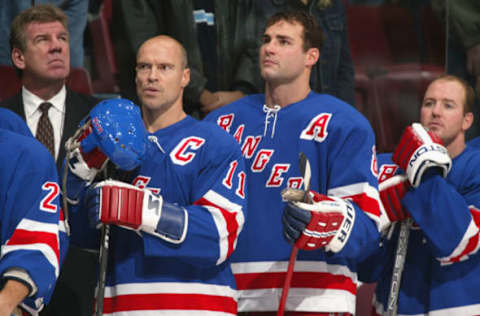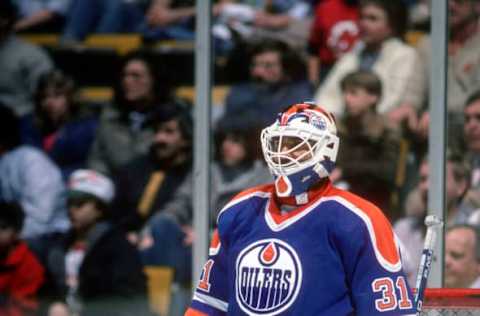Mark Messier’s Trade Tree Between the New York Rangers and Edmonton Oilers


When we touched on the mini Mark Messier trade tree a few months ago, it picked up a ton of requests from fans asking for the original deal. As a hockey historian, it’s only fitting to share the incredible story of the Mark Messier trade tree and how one of the greatest players the Rangers have ever iced game to the Garden. From being Gretzky’s right-hand man to delivering on a promise to the New York Rangers fanbase, Mark Messier’s story begins.
A kid from Alberta, Canada, Mark Messier was born on January 18, 1961. Known for leadership and the ability to play at a high level regardless of those around him, the Messiah earned praise as a child, starting his youth hockey career with the Spruce Gorove Mets of the Alberta Junior Hockey League. In 57 games as a 16-year-old, Messier had 27 goals and 39 assists for 66 points. The following season with the St. Albert Saints, he had 25 goals, and 49 assists for 74 points in 54 games.
In the 1978-79 season, Messier wanted to play professional hockey but was too young for the NHL. In the modern era, the options would be Europea or go back to junior, but in the late 1970s, there was a fizzling rival of the WHA that just so happened to have a lower age requirement called the WHA. For younger or newer fans, the World Hockey Association was a rival league that did not last very long.
Seeking to play professionally, a desperate team in Indiana called the Indianapolis Racers was looking to replace some kid they’d just traded named Wayne Gretzky. I’m not sure whatever happened to him, and Messier was brought in to fill those shoes. However, after five games, the organization folded due to years of reckless spending. Truthfully, this fate was known before Gretzky’s trade.

Messier ended the WHA season with the Cincinnati Stingers, scoring one goal and ten assists for 11 points in 47 games as a 17-year-old. While this was not earth-shattering totals, there was value in the performances of the Alberta native. After the season, the WHA and NHL merged. This was partly due to the Stingers folding at the end of the year, leaving just four operational franchises.
All four franchises are still in the NHL today, albeit three have been relocated. The Hartford Whalers are now the Carolina Hurricanes. The Quebec Nordiques are now the Colorado Avalanche, the original Winnipeg Jets are now the Arizona Coyotes and those plucky Edmonton Oilers are the only ones not to move. What this meant for Messier was that he would have to go through the draft.
Messier was taken #48 overall by the Edmonton Oilers in the 1979 NHL draft, and that is where we started to see the league’s new powerhouse team warm up. After 33 points in 75 games as a rookie, Messier cruised past the point-per-game mark as a junior with 50 goals and 38 assists for 88 points by year three. He won the Conn Smythe in 1984 as playoff MVP as the Oilers won the cup.
He’d win the Hart Trophy as league MVP in 1990 and the Lester B Pearson, or what is called the Ted Lindsay award today, as most valuable player as voted by the NHL Players Association. Messier would follow this up with one more season in Edmonton before the Oilers’ management started to admit that the sun was getting low on their dynasty. Gretzky was traded in 1988, Jari Kurri a little later, Grant Fuhr had gone too, and it seemed the writing was on the wall for Messier.

The Trade
In 1991-92, Messier became a New York Ranger. He and Jeff Beukeboom came to New York in exchange for Louie Debrusk, Bernie Nicholls, Steven Rice, and David Shaw. Edmonton’s then-owner Peter Pocklington has reiterated how difficult it was to sustain the success of the Oilers with the inflated payrolls and the ever-increasing pressure to pay the players more when the team wasn’t making enough money to justify it.
I doubt anyone cares about the reason for the deal, but Messier came to Broadway, and he did it in a big way. During his ten seasons in the Big Apple (albeit across two stints), Messier recorded 250 goals and 441 assists for 691 points in 698 games. He won the Hart Trophy and the Lester B. Pearson in his first season in New York after a 35-goal season in which he added 72 assists for 107 points.
Messier’s most iconic moment in New York, however, was probably away from the ice. During the 1994 Stanley Cup Playoffs, the Rangers found themselves in a hole down 3-2 in the Eastern Conference Finals to the New Jersey Devils. Messier offered a promise to the New York Rangers. There would be a game seven. In a do-or-die game six, the Ranger captain had a hat trick, making good on his word.
From that point on, it seemed like fate only had one team in mind that could lift that storied trophy. After beating the Devils in game seven, the Rangers went back to the Stanley Cup Finals against the Vancouver Canucks. We all know how it ended, with the Rangers lifting the cup for the first time since 1940. It remains the longest amount of time between Stanley Cups today, but that will be passed if the Maple Leafs ever win the cup again
Messier departed in free agency to the Vancouver Canucks. He would be back a few years later, where the Messier trade tree with San Jose comes from. However, that isn’t part of this, so moving on to Jeff Beukeboom. Beukeboom spent eight years in New York, scoring 18 goals and 72 assists for 90 points, but he was here to fight with 1157 penalty minutes during his time in New York.
Beukeboom won the 1994 Stanley Cup in New York, but he was never traded, retiring as a Ranger at the end of the 1998-99 season. It’s a brisk end to the New York side of this deal, but if you have ever wondered what became of what the Rangers gave up to acquire the Messiah, let’s jump into it.

Oilers Side
So, the Oilers got back Louie Debrusk, Bernie Nicholls, Steven Rice, and David Shaw. Starting with Louie DeBrusk because he was not traded. DeBrusk spent 6 years in Edmonton, playing in 228 games, putting up 19 goals and 12 assists for 31 points. DeBrusk put up 797 penalty minutes in his time in Edmonton, proving he was more of the punch-you-in-the-face type of player than a scoring forward.
Moving onto the other player that was not traded in this deal, and that is Steven Rice. Rice played in 94 games as an Oiler, scoring 19 goals and 20 assists for 39 points. He had 66 penalty minutes proving again 1990s hockey had the tendency to be more like a brawl than a hockey game. Rice would go to Hartford and even follow the organization down to Carolina after relocation. Rice’s exit from Edmonton was an offer sheet, not a trade.
Let’s move on to David Shaw because this is going to become slightly nuts. A somewhat pleasing fact about Shaw is that he was traded everywhere he went in his career. From Quebec to New York, New York to Edmonton, Edmonton to Minnesota, Minnesota to Boston, Boston to Tampa, and Tampa to San Jose. He had 12 games as an Oilers scoring a goal and an assist, before he was flipped for Brian Glynn.
Glynn played in 89 games as an Oiler scoring six goals and 18 assists for 24 points. He was packaged and shipped off to the Ottawa Senators for a 1994 8th-round pick used on Rob Guinn. Guinn never made the NHL and was never dealt. On a darker note, Guinn was fatally wounded in a car accident in 2008. Taken from the hockey world far too young.
It’s difficult to move on from such a dark note, but Bernie Nicholls’ branch still needs to be discussed. Nicholls spent 95 games in Edmonton, scoring 28 goals and 61 assists for 89 points. Unlike a lot of other players on here, he was actually an offensive-minded player. Nicholls was flipped to the New Jersey Devils for Zdeno Ciger and Kevin Todd.
Ciger spent 204 games as an Oilers, netting 64 goals and 91 assists for 155 points. Good totals, but he would leave the league after the 1995-96 season. He tried to come back in 2001-02, but it just didn’t work. He wasn’t dealt by the Oilers, so this ends. As for Kevin Todd, he spent 25 games as an Oiler, scoring four goals and nine assists for 13 points. He was sent to the Chicago Blackhawks for Adam Bennett. Bennett played in 48 games, three goals and six assists, but wasn’t dealt.

Overall
Because I am sticking to only trades, this tree is not as big as it could be. I mentioned the offer sheet exit, which I didn’t go down, but that could, in theory, be tied to players like Chris Pronger and Oscar Klefbom if you follow that path down the line, but hey, this looks better. It’s not as long as the Rick Nash trade tree you can find on this website, but there’s a lot to like about this.
We’re all aware of the success the Rangers had under the leadership of Messier. There are several hundred reasons that number eleven hangs from the rafters at Madison Square Garden. What Messier did for this organization and this city is something that very few players will have the ability to do throughout their careers. To get a hockey Hall of Famer for something like this is incredible.
That 1994 Stanley Cup is not won by the Blueshirts if this deal is not made. I know that this focuses a little bit on the Oilers and what they got back for Messier, but in comparison to what the Rangers got from him, it’s not close. Ultimately, you want to win the Stanley Cup when adding star talent. New York did that, and Messier was a big reason it was achieved. On top of that, everything else he did was just gravy.
This league is now very different than it was at the time of this deal. Star players do not get traded like they used to, and the core of a dynasty is rarely sold off as the Oilers did in the late 1980s and early 1990s. You won’t see many teams decide they don’t want this player who sits third all-time in their franchise records 30 years later. We’ll never see another deal like this again, so if I may quote Sam Rosen, the memory of this one will need to “last a lifetime”.